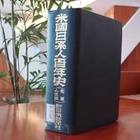Read Part 8, "Japanese Americans in Southern California ~ Part 4" >>
The Centennial History of Japanese Americans in the United States introduces the footsteps of Japanese Americans in each state, so far I have been looking at the pages on California. I have introduced Northern California once and Southern California four times . To conclude my California article, I would like to read about 60 pages about Japanese Americans in Central California, including Fresno.
The Centennial History also provides detailed geographical information about the region. It states, "Central California is a vast plain located between the Coast Range and the Sierra Nevada Mountains, stretching approximately 50 miles east to west and 200 miles north to south, and consisting of five counties: Madera, Fresno, Kings, Tulare, and Kern. Fresno is an agricultural center that could be called the capital of Central California."
"Several rivers originating from the Sierra Mountains and Yosemite have been used for irrigation, and the Great Plains of Central California are being cultivated at rapid rates each year. All kinds of agricultural products, including grapes, cotton, citrus fruits, and other fruits and vegetables, are produced and shipped to markets in the East. In addition, raisins, a specialty of Central California, are exported all over the world, and their deliciousness and quality are praised in every corner of the world."
Many of the Japanese who came to this area also worked in agriculture. The population of Central California was about 950,000 in the 1959 census, of which about 14,000 were Japanese.
The first Japanese people came to Fresno around 1880, when an American who had been employed by the city of Tokyo and then returned to Japan brought two men, Nakayama Sanen and Sasajima Tadashi, with him as servants. The main reason so many Japanese came to Fresno was that "Buddhist church missionaries encouraged them to own land, and even started a real estate company to establish the foundation for permanent settlement."
Mr. Fresno
The man who was chosen as "Mister Fresno" in Fresno was Setsugu Sakamoto. Born in Asa County, Hiroshima Prefecture in 1884, he arrived in Tacoma, Washington at the age of 15, learned English while working in Sacramento, and opened a grocery store in Fresno in 1909, after which he started various businesses.
His achievements included setting a precedent for legal land ownership for Japanese Americans and playing a major role in maintaining land ownership rights for Japanese Americans in central California. He also became chairman of the Fresno Japanese Association before the outbreak of the war, and after the war began, "he sent a telegram to the President through Congressman Gerhardt pledging his loyalty, which was broadcast on the radio across the U.S. and was also announced at an emergency session of Congress declaring war on Japan, drawing a full round of applause. Thanks to Mr. Sakamoto's courageous and kind actions, Fresno Japanese Association executives left a lasting mark in not having a single person detained."
The beating of a police officer just after the outbreak of war
At the start of the war, there was relatively little unrest in Fresno, but there was one time when eviction came as a great shock to Japanese Americans. "When the order for the complete eviction of Japanese people on the Pacific coast was issued in February 1942, the area east of Highway 99, which runs through central California, was initially announced as a white zone (a non-eviction area). However, large numbers of people from all the other eviction zones flocked to the area, provoking local Americans, and later the area also became an eviction zone, causing great confusion for the Japanese people in the area who had felt safe there..."
The Centennial History reprints an article about the chaos that occurred at the time, written by the Fresno branch of the Nichibei Jiji newspaper, which was a roundtable discussion of influential Japanese people. The article talks about the chaos that occurred before and after the sudden eviction, including an incident in which a police officer was assaulted. The "police officers" were presumably police officers, but the incident involved three young Japanese men from outside the area who, after getting into an argument with a police officer in Delray's Japanese town, punched the officer, stole his handcuffs and pistol, and ran away. As a result, the Japanese raised $825 and sent it to the officer as an apology.
In addition, it is said that due to the eviction, a columbarium was hastily built in a Fresno cemetery to store the more than 400 remains.
A lonely first generation after the war?
The topic also touches on postwar Japanese families, with the following interesting remarks being made about the first and second generation:
"It's good that the lifestyle of the second generation of Koreans in America is changing, but I feel lonely for the first generation. I think there are a lot of problems lurking in their homes, even though they haven't surfaced yet." (Miyamoto)
"I believe that the reason why the Issei's attitude changed so completely was as a result of the war. Before the war, their lives were centered on Japan, but after the war, they became centered on America. Furthermore, after the war, their relatives and friends were scattered all over the United States, so it could be said that the Japanese way of thinking also became more American." (Mikami)
In Madera County, in the direction of Sacramento in central California, there is the town of Livingston, where the Yamato Colony is famous in the history of Japanese immigration. It is a village of Japanese settlers established by Abiko Kyutaro in 1910. A similar colony was also established in nearby Cortez. The book also contains a detailed account of the colony's business, which developed through the formation of an agricultural cooperative.
(Note: Honorifics have been omitted. Quotations have been as original as possible, with some modifications. Place names have been based on the names in the "Centen-nen-shi.")
© 2014 Ryusuke Kawai







